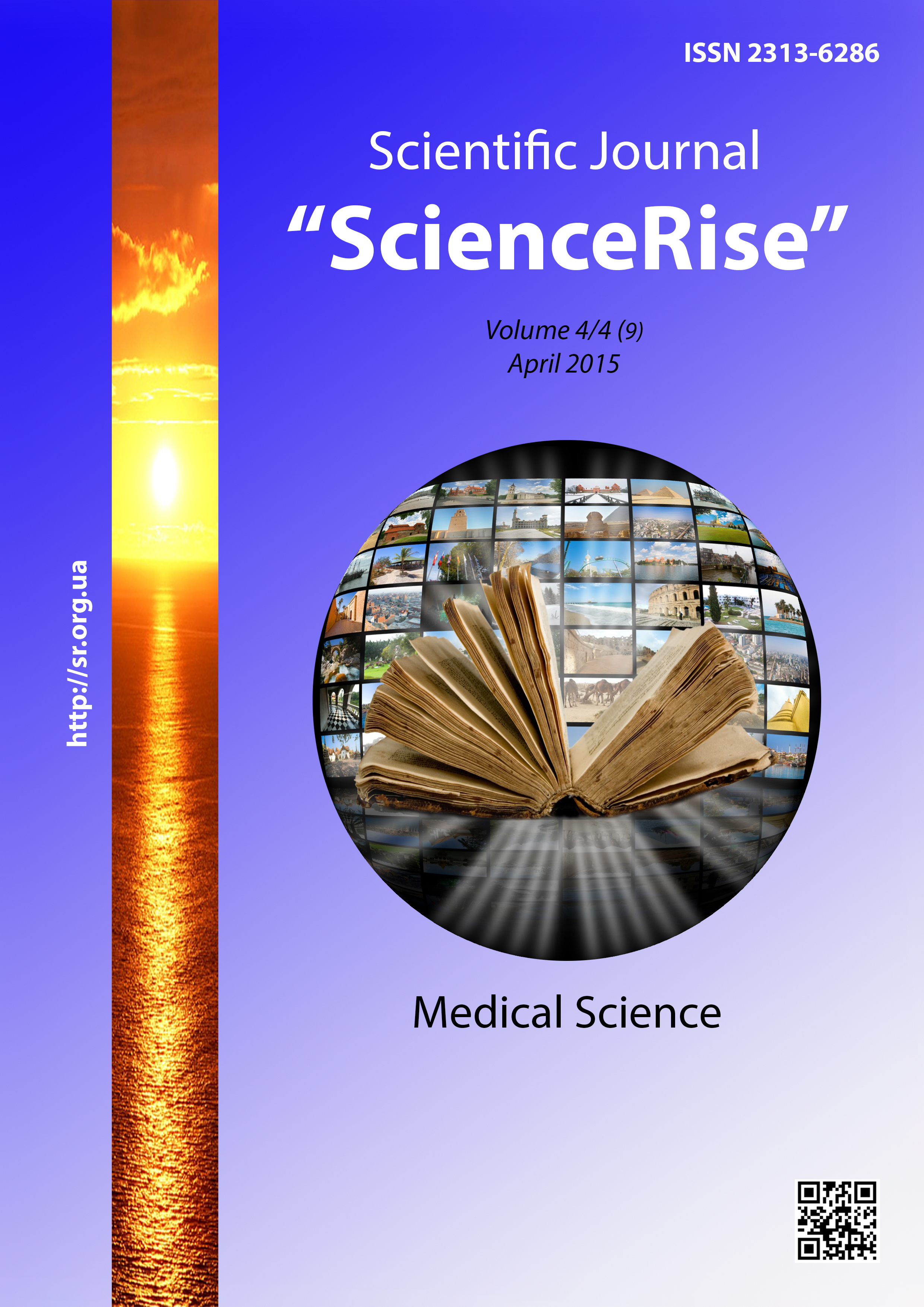Influence of drug correction options of postoperative motility disorders of the gastrointestinal tract on inflammatory and anti-inflammatory markers
DOI:
https://doi.org/10.15587/2313-8416.2015.41607Keywords:
postoperative ileus, L-argininum, simeticonum, neostigminum, inflammationAbstract
Introduction. Postoperative dysmotility of the gastrointestinal tract is a common complication after operations on the abdominal cavity. Intestinal inflammatory response plays an important role in the development of postoperative motility disorders.
Materials and methods. After Local Ethics Committee approval and obtaining informed consent, 103 patients were prospectively divided into 4 groups depending on the characteristics of post-operative intensive care. In the 1 (control) group (n=27), patients after operation received stimulation of the gastrointestinal tract with metoclopramidum and neostigminum. In group 2 (n=24), patients received L-arginine and metoclopramidum. In the group 3 (n=25) patients received metoclopramidum and simeticonum. In group 4 (n=27), patients received L-arginine, metoclopramidum and simeticonum. Markers of inflammation (leukocyte levels, fibrinogen, IL-1α, TNFα, IL-10, the calculation of leukocyte index of intoxication) were studied preoperatively, after 1,3 and 7 days.
Results and Conclusion. Pathological process in the abdomen accompanied by the development of postoperative gastrointestinal dysmotility, increase in the number of white blood cells to 58.8% (p <0.001) and fibrinogen to 55.5% (p<0.001), imbalance of the inflammatory response of the body in the form of increased pro-inflammatory IL-1α by 25.1% (p = 0.047) with a simultaneous decrease the level of TNF more than 400% (p <0,001), before surgery. Group 1 patients inflammatory response persisted for more than 7 days after the operation and leads to depletion of proinflammatory cytokine system, as indicated by the levels of pro-inflammatory IL-1α and TNFα, whose values were below normal at 503% (p <0.001) and 57.9% (p <0.001). When using metoclopramide and L-arginine manifestations of inflammatory response persisted throughout the observation period, but progressively, and at 7 days after operation were smaller than in the other groups. So, in group 2 at 7 days after operation the level of IL-1α was the highest, exceeding the value of 1 to 367% (p <0.001), 3 - by 314% (p <0.001), 4 - 400% (p <0.001). At the same, TNFα levels in group 2 did not differ statistically significantly from preoperative. In group 1 at 7 days after surgery there was increase of anti-inflammatory IL-10 level is above normal and figures 3 and 4 groups at 78.2% (p <0.001) and 124% (p <0.001) and 60, 2% (p = 0.001).
The most rapid restoration of peristalsis was using metoclopramide and L-arginine. So, in group 2 independent carminative observed after 2.22 days after operation that 21.8% (p = 0.001) was lower than in group 1, 29.7% (p <0.001) - 3 groups, 26 6% (p = 0.003) - 4 group. This reduces the length of stay in ICU. 100% of patients 3 and 4 and the absolute majority of the patients 1 and 2 groups at 28 days after surgery VIII reached the level of quality of life scale RLAS
References
Rychter, J., Clave, P. (2013). Intestinal inflammation in postoperative ileus: pathogenesis and therapeutic targets. Gut, 62 (11), 1534–1535. doi: 10.1136/gutjnl–2012–304176
Vather, R., Trivedi, S., Bissett, I. (2013). Defining postoperative ileus: results of a systematic review and global survey. Journal of Gastrointestinal Surgery, 17 (5), 962–972. doi: 10.1007/s11605-013-2148-y
Prasad, M., Matthews, J. B. (1999). Deflating postoperative ileus. Gastroenterology, 117 (2), 489–492. doi:10.1053/gast.1999.0029900489
Asgeirsson, T., El–Badawi, K. I., Mahmood, A. (2010). Postoperative ileus: it costsmore than you expect. Journal of the American College of Surgeons, 210 (2), 228–231. doi: 10.1016/j.jamcollsurg.2009.09.028
Boeckxstaens, G. E., de Jonge, W. J. (2009). Neuroimmune mechanisms in postoperative ileus. Gut, 58 (9), 1300–1311. doi: 10.1136/gut.2008.169250
Kalff, J. C., Carlos, T. M., Schraut, W. H., Billiar, T. R., Simmons, R. L., Bauer, A. J. (1999). Surgically induced leukocytic infiltrates within the rat intestinal muscularis mediate postoperative ileus. Gastroenterology, 117 (2), 378–387. doi: 10.1053/gast.1999.0029900378
Kalff, J. C., Schraut, W. H., Simmons, R. L., Bauer, A. J. (1998). Surgical Manipulation of the Gut Elicits an Intestinal Muscularis Inflammatory Response Resulting in Postsurgical Ileus. Annals of Surgery, 228 (5), 652–663. doi: 10.1097/00000658-199811000-00004
Kolosovsky, A. A., Kan, S. L., Churliaev, Y. A., Zoloeva O. S. (2012). The functional state of the microcirculation of the intestine with diffuse peritonitis. General resuscitation, 8, 33–37.
Ueno, C., Fukatsu, K., Maeshima, Y. (2010). Arginine–enriched total parenteral nutrition improves survival in peritonitis by normalizing NFkappaB activation in peritoneal resident and exudative leukocytes. Annals of Surgery, 251 (5), 959–965. doi: 10.1097/SLA.0b013e3181d775ea
Yeh, C. L., Hsu, C. S., Chen, S. C. (2007). Effect of arginine on cellular adhesion molecule expression and leukocyte transmigration in endothelial cells stimulated by biological fluid from surgical patients. Shok, 28 (1), 39–44. doi: 10.1097/shk.0b013e31802f0190
van Bree, S. H., Nemethova, C., Gomez–Pinilla, P. J. (2012). New therapeutic strategies for postoperative ileus. Nat. Rev. Gastroenterol. Hepatol, 9 (11), 675–683. doi: 10.1038/nrgastro.2012.134
Downloads
Published
Issue
Section
License
Copyright (c) 2015 Сергей Геннадиевич Дёмин, Людмила Василівна Новицька-Усенко

This work is licensed under a Creative Commons Attribution 4.0 International License.
Our journal abides by the Creative Commons CC BY copyright rights and permissions for open access journals.
Authors, who are published in this journal, agree to the following conditions:
1. The authors reserve the right to authorship of the work and pass the first publication right of this work to the journal under the terms of a Creative Commons CC BY, which allows others to freely distribute the published research with the obligatory reference to the authors of the original work and the first publication of the work in this journal.
2. The authors have the right to conclude separate supplement agreements that relate to non-exclusive work distribution in the form in which it has been published by the journal (for example, to upload the work to the online storage of the journal or publish it as part of a monograph), provided that the reference to the first publication of the work in this journal is included.

